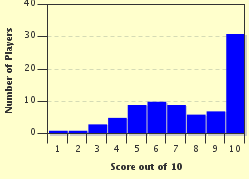Quiz Answer Key and Fun Facts
1. Guyanese people are well noted for their hospitality. If you happen to visit the country during the Christmas holidays, you're likely to be served a brownish-black stew comprised of meats flavored with cinnamon, hot peppers and a dark sauce called cassava cassareep. What is this blackish dish called?
2. When a Guyanese male demonstrates effeminate qualities, the consensus is often that such a person is NOT a man. He's what North Americans term "gay". Which of the following terms is the common Guyanese term for such a man?
3. Legend has it that should you stumble upon a corked green bottle while walking the streets of Guyana, you should avoid opening it at all costs. Failure to heed this advice can result in the release of an evil spirit which thrives on milk and banana. Which of these is said to be released from the bottle?
4. You've heard about witches on broomsticks, vampires and of those who dance naked in circles in the moonlight. Well, in Guyana, you'll hear talks about an "ole higue". According to Guyanese folklore, what is the "ole higue" notorious for?
5. Traditionally, Afro-Guyanese engage in a celebration on their wedding eve night whereby the two families meet. They do a characteristic dance to folk songs, eat, drink and make merry. This prenuptial Afro-Guyanese celebration is called Queh-Queh (Kwe Kwe).
True or False?
6. When driving in remote areas of Guyana at night one should be watchful for cows sleeping in the streets. During the daytime there're likely to be kids playing in the streets, and one must park momentarily to allow them to remove their wickets and get their act out of the path of traffic.
Which of the following sports is a favorite of Guyanese lads and entails use of a bat, ball and wicket ?
7. At times there's a serious clash between cultural and medical practices in Guyana. With regards to cultural practices, which of the following maladies is predominant in kids and manifested by loss of appetite, weight loss and diarrhea?
8. During a Guyana-Venezuelan border dispute, Guyanese, in their zeal to protect their territory, were seen chanting slogans like "Stop de 'eye-pass'! Not a blade of grass".
Alternately, two individuals may have an altercation and one may say "Dis eye-pass gat to done now!"
Which of the following is the nearest equivalent of the Guyanese term "eye-pass"?
9. Referred to as "Mash", which of the following Guyanese celebrations usually takes place on February 23rd?
10. When someone in a Guyanese community dies, residents in the neighborhood assemble at the home of the deceased to offer support to the bereaved relatives. The sessions last throughout the night and often continue nightly until the individual is buried. By what term do Guyanese call this nightly vigil?
Source: Author
yency
This quiz was reviewed by FunTrivia editor
stedman before going online.
Any errors found in FunTrivia content are routinely corrected through our feedback system.

